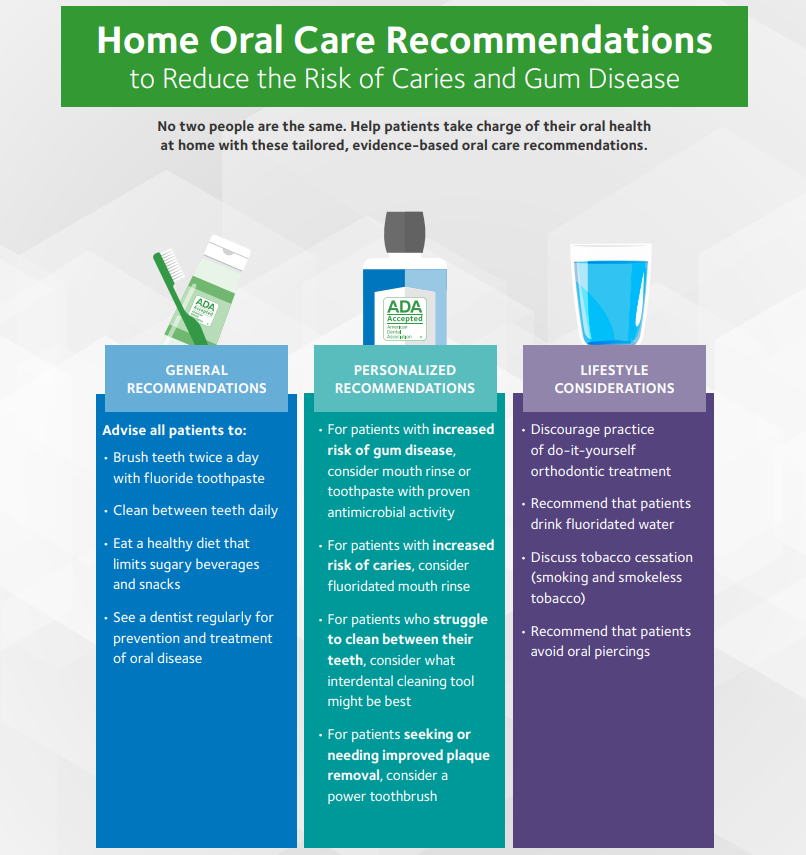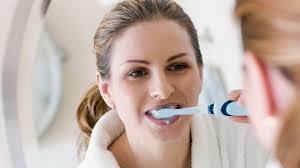From The American Dental Association
“General Recommendations for the Prevention of Caries and Gingivitis
While a seemingly simple statement, the guidance for brushing twice daily with a fluoride toothpaste weaves together a number of discrete components.Toothbrushing frequency
Review of the scientific literature, along with guidance from governmental organizations and professional associations found sufficient evidence to support the contention that twice-daily brushing, when compared with lower frequencies, was optimal for reducing risk of caries,2-4 gingival recession or periodontitis.5-7 It is important to recognize that in these studies, it was the frequency of tooth-brushing with a fluoride toothpaste that was evaluated rather than tooth-brushing alone.
Fluoride toothpaste
Although the measures used to assess the benefit varied, studies examining the effect of over-the-counter (OTC) fluoride dentifrice on caries incidence in children and adolescents found the fraction of caries prevented ranged from 16% per tooth to 31% per surface versus placebo or no dentifrice, and concluded that fluoride-containing toothpaste was effective in caries control.4, 8, 9 In addition, high level evidence shows that 5,000 ppm fluoride (available with a prescription) results in significantly more arrest of root caries lesions than use of OTC levels of fluoride (1,000 – 1,500ppm).10
Toothbrushing duration
Data examining the question of optimal duration of daily tooth-brushing encounters relies on plaque indices which are surrogate measures rather than direct measure of caries or gingivitis. Understanding that the use of surrogate measures decreases the certainty with which a recommendation can be made, the available systematic reviews found a brushing duration of two minutes was associated with bigger reduction in plaque than brushing for a single minute.11, 12 Two minutes per whole mouth can also be expressed as thirty seconds per quadrant or about four seconds per tooth.
2) Clean between your teeth daily
While cleaning between teeth is important to maintaining oral health, it is a concept that must overcome several barriers to adoption. ”Flossing” is often used as a shorthand, common term for interdental cleaning, which can become problematic in the real world where many report a strong distaste for that particular activity.13 Some people presume flossing as ineffective or unnecessary, which can also make it harder for them to adopt the daily habit. Flossing is a technique-sensitive intervention14 as exemplified by the disparity in benefit observed when comparing study designs involving self-flossing and professional flossing.15 Where patients do not see positive results from flossing, they may not continue to do so.
Using flossing as shorthand for interdental cleaning can also be problematic in that patients may be unaware of alternative devices that may be more pleasant or effective for them. A meta-review, which included the available devices developed for this purpose (i.e. dental floss, interdental brushes, oral irrigators, and woodsticks), addressed the question “What is the effect of mechanical inter-dental plaque removal in addition to tooth brushing on managing gingivitis in adults?” The strength of the evidence on the benefit ranged from weak to moderate depending on the device in question.16
Thus, there may not be one “best” interdental cleaning method; rather, the best method for any given patient may be one in which they will regularly perform. A guiding principle which is relevant to interdental cleaning is: “best care for each patient rests neither in clinician judgment nor scientific evidence but rather in the art of combining the two through interaction with the patient to find the best option for each individual.”17
3) Eat a healthy diet that limits sugary beverages and snacks
While eating a healthy diet is important for overall health and well-being, a review of the literature found little in terms of the effects of micronutrients on the risk of caries or periodontal disease. However, the conclusion of numerous systematic reviews on the effect of the macronutrient content of the diet, specifically of sugar, is that there is an association between sugar intake and caries.18-20 A review of the evidence supporting nine international guidelines recommending decreased consumption of sugar found consistent recommendations from all the groups while noting that they relied on different data and rationales.18
4) See your dentist regularly for prevention and treatment of oral disease
Viewed through the prism of the primary prevention of caries and/or gingivitis, a systematic review of the literature failed to arrive at consensus regarding optimal recall frequency to minimize either caries21, 22 or periodontal disease risk23 in part due to limited availability of studies addressing this topic. Nonetheless, in terms of the balance between resource allocation and risk reduction, it can be concluded that there is merit in tailoring a patient’s recall interval to individual need based on assessed risk of disease.21, 24
Previously, the ADA Healthy Smile Tips advised people to “Visit your dentist regularly.” However, dentists are doctors of oral health, which encompasses both the prevention and treatment of oral disease. The current recommendation goes a step further than its predecessor in articulating the duality of the dental visits.”







